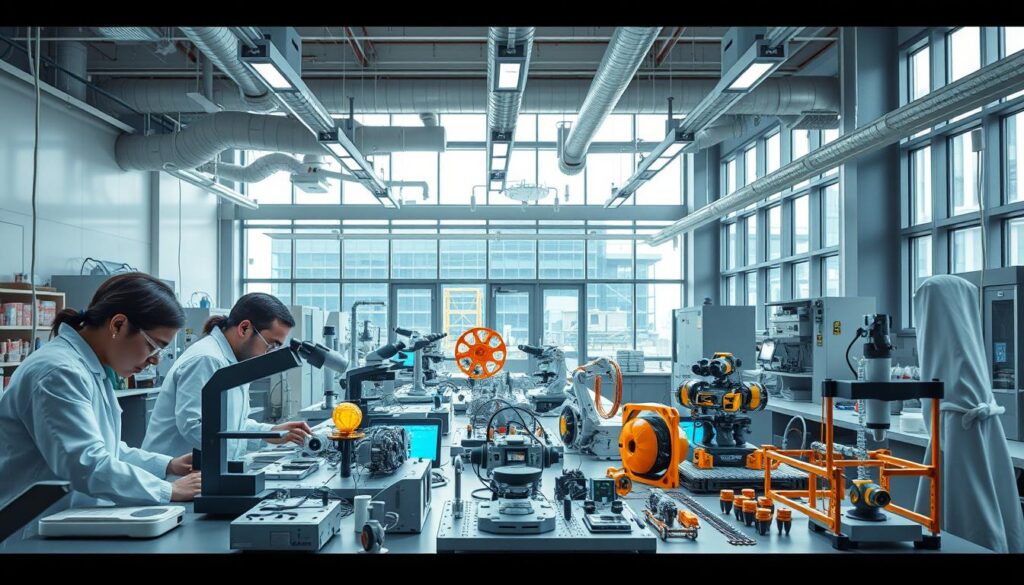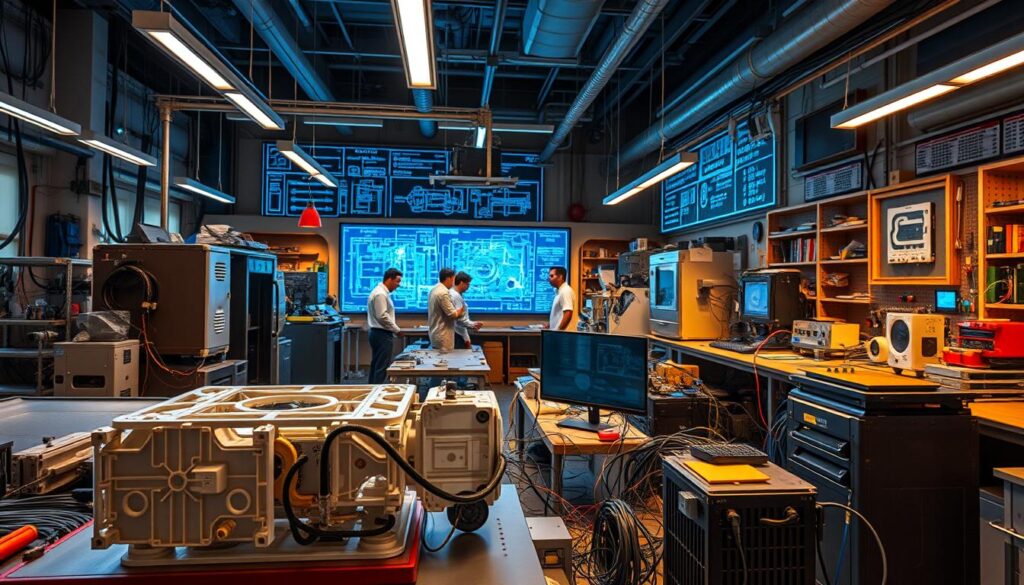The world is witnessing a technological revolution, with groundbreaking ideas transforming industries and lives. At the heart of this change is the convergence of diverse engineering disciplines, driving revolutionary technology that was once considered science fiction.
The book “Frontiers of Engineering Innovation: Interdisciplinary Approaches and Applications” explores how different fields of engineering come together to push the boundaries of what is possible. This interdisciplinary approach is crucial in addressing complex global challenges, from sustainable energy to advanced healthcare solutions.
Key Takeaways
- Engineering innovation is driving technological advancements.
- Interdisciplinary approaches are key to groundbreaking discoveries.
- Revolutionary technologies are transforming industries and improving lives.
- Diverse engineering disciplines converge to address global challenges.
- The future of innovation lies in collaborative and interdisciplinary efforts.
Understanding Engineering Innovation
As technology continues to evolve, engineering innovation plays a crucial role in shaping the future of various industries. The 2021 US Frontiers of Engineering symposium highlighted cutting-edge developments in multiple engineering fields, underscoring the significance of innovation in addressing complex challenges.
Engineering innovation encompasses a broad range of activities, from innovative design to the development of new technologies. It involves applying scientific knowledge to create practical solutions that improve people’s lives and transform industries.
Definition of Engineering Innovation
Engineering innovation refers to the process of applying engineering principles to develop new or improved technologies, products, and processes. It involves technology advancement through research and development, leading to innovative solutions that address real-world problems.
For instance, the symposium discussed advancements in fields like innovation engineering, which focuses on creating systematic approaches to innovation, enabling companies to stay competitive in a rapidly changing landscape.
Importance in Today’s World
In today’s world, engineering innovation is more critical than ever. It drives economic growth, improves quality of life, and helps address global challenges such as climate change and resource depletion.
The impact of engineering innovation can be seen in various sectors, from energy and transportation to healthcare and construction. For example, innovations in renewable energy solutions are crucial for reducing our reliance on fossil fuels and mitigating climate change.
| Sector | Innovation | Impact |
|---|---|---|
| Energy | Renewable Energy Solutions | Reduced reliance on fossil fuels |
| Transportation | Electric Vehicles | Lower emissions, improved air quality |
| Healthcare | Advanced Medical Devices | Improved patient outcomes, enhanced care |
By fostering a culture of innovation and investing in engineering research and development, we can unlock new opportunities for growth and progress, ultimately creating a better future for generations to come.
Historical Milestones in Engineering

From ancient structures to modern marvels, engineering innovation has been a continuous journey. The field has seen numerous milestones that have significantly impacted human progress.
Key Innovators Who Shaped Engineering
Throughout history, several key innovators have left an indelible mark on the field of engineering. Figures such as Leonardo da Vinci, known for his designs of machines and mechanisms, and Isambard Kingdom Brunel, who revolutionized bridge construction, have been instrumental in shaping the discipline.
Other notable engineers include George Stephenson, who built the first public inter-city railway line, and Emily Warren Roebling, who played a crucial role in the construction of the Brooklyn Bridge.
Major Engineering Breakthroughs Over the Decades
The history of engineering is marked by several major breakthroughs that have transformed industries and societies. Some of these include the development of creative engineering solutions in bridge construction, the introduction of forward-thinking solutions in transportation systems, and the implementation of disruptive engineering innovations in communication technologies.
| Decade | Breakthrough | Impact |
|---|---|---|
| 1800s | Development of steam locomotives | Revolutionized transportation |
| 1900s | Introduction of electricity grids | Transformed urban life and industries |
| 2000s | Advancements in digital communication | Enabled global connectivity |
These breakthroughs have not only solved complex problems but have also opened up new avenues for future innovations, demonstrating the power of engineering to shape the world.
Current Trends in Engineering Innovation
Innovation in engineering is being propelled by the convergence of various disciplines, leading to groundbreaking solutions. The collaboration between experts from different fields, such as the partnership between Robert C. Alaniz and Arul Jayaraman at Texas A&M, exemplifies this trend. Their work in interdisciplinary research represents a significant shift towards tackling complex challenges through a multifaceted approach.
Sustainable Engineering Practices
Sustainable engineering practices are becoming increasingly important as the world grapples with environmental challenges. Engineers are now focusing on designing systems and products that minimize environmental impact. This includes the development of renewable energy sources, sustainable materials, and energy-efficient technologies. The adoption of sustainable practices not only benefits the environment but also enhances the efficiency and cost-effectiveness of engineering projects.
Digital Transformation in Engineering
The digital transformation in engineering is revolutionizing the way projects are designed, executed, and maintained. Technologies such as Building Information Modeling (BIM), Internet of Things (IoT), and Artificial Intelligence (AI) are being integrated into engineering practices. This digital shift enables greater precision, reduces costs, and improves project timelines. The use of digital tools also facilitates better collaboration among stakeholders and enhances the overall quality of engineering projects.
Advancements in Robotics and AI
Advancements in robotics and AI are transforming the engineering landscape by enabling the development of more sophisticated and autonomous systems. Robotics is being used in various applications, from manufacturing to healthcare, improving efficiency and reducing the risk of human error. AI algorithms are being employed to analyze complex data, predict outcomes, and optimize engineering processes. The integration of robotics and AI is expected to drive significant innovation in the engineering sector.
The Role of Higher Education in Engineering

The landscape of engineering is continually evolving, thanks in part to the contributions of higher education institutions. These institutions are not just centers of learning; they are incubators for cutting-edge engineering and forward-thinking solutions. By fostering an environment that encourages innovation and experimentation, higher education plays a crucial role in shaping the future of engineering.
Importance of STEM Programs
STEM programs (Science, Technology, Engineering, and Mathematics) are the backbone of engineering education. These programs provide students with a comprehensive understanding of the principles and practices that underpin modern engineering. By emphasizing hands-on learning and real-world applications, STEM programs equip students with the skills needed to develop groundbreaking ideas and turn them into reality.
The importance of STEM programs cannot be overstated. They not only prepare students for careers in engineering but also foster a mindset that is conducive to innovation and problem-solving. As such, institutions that offer robust STEM programs are crucial in driving the next generation of engineers and innovators.
Collaborative Projects Between Universities and Industries
One of the most effective ways that higher education contributes to engineering innovation is through collaborative projects between universities and industries. These collaborations provide a platform for academics and professionals to work together on real-world problems, leading to the development of practical and innovative solutions.
For instance, the 2021 US Frontiers of Engineering symposium brought together engineers from universities and industries, highlighting the role of higher education in fostering innovation. Such initiatives not only advance the field of engineering but also provide students with valuable experience and exposure to industry practices.
By working together, universities and industries can drive forward-thinking solutions that might not have been possible within the confines of a single organization. This collaborative approach is essential for tackling the complex challenges that face modern society and for continuing to push the boundaries of what is possible in engineering.
Engineering Innovations in Energy
Creative engineering solutions are being implemented across the energy sector, driving significant advancements in renewable energy and smart grid technology. These innovations are crucial for addressing the global energy challenges we face today.
Renewable Energy Solutions
Disruptive engineering innovations have made solar and wind energy more efficient and cost-effective. For instance, advancements in solar panel technology have led to higher energy conversion rates, while larger, more efficient wind turbines have increased energy output.
- Improved solar panel efficiency
- Advanced wind turbine designs
- Enhanced energy storage systems
Smart Grid Technology
Smart grid technology is another critical area where engineering innovations are making a significant impact. By integrating advanced communication and control systems, smart grids enable real-time management of energy distribution, improving efficiency and reliability. Revolutionary technology such as IoT devices and AI algorithms are being used to predict energy demand, detect faults, and optimize energy flow.
- Real-time energy management
- Predictive maintenance
- Enhanced grid security
Impact of Engineering on Transportation

Engineering innovations are revolutionizing the way we travel, making transportation faster, cleaner, and more efficient. The development of electric vehicles and autonomous vehicles represents significant advancements in transportation engineering.
Evolution of Electric Vehicles
Electric vehicles (EVs) have come a long way since their inception. With cutting-edge engineering, EVs are becoming more viable, offering a sustainable alternative to traditional fossil fuel-based transportation. The innovation in battery technology has been a crucial factor in this evolution, enabling EVs to travel longer distances on a single charge.
As the world shifts towards more forward-thinking solutions, the demand for EVs is expected to rise, driven by government policies and declining battery costs. This shift is not just about the vehicles themselves but also about the infrastructure that supports them, including charging stations and maintenance facilities.
Innovations in Public Transit Systems
Public transit systems are also undergoing a transformation, thanks to innovative design and engineering. Modern public transit is becoming more efficient, reliable, and user-friendly, incorporating technologies like real-time tracking and smart traffic management.
For instance, many cities are now adopting bus rapid transit (BRT) systems, which offer a cost-effective solution to improving public transportation. These systems are designed to be forward-thinking, with dedicated lanes and efficient boarding processes that reduce travel times.
Future of Autonomous Vehicles
The future of transportation is likely to be dominated by autonomous vehicles (AVs), which promise to revolutionize the way we travel. With the potential to significantly reduce accidents caused by human error, AVs represent a cutting-edge engineering achievement.
As AV technology continues to advance, we can expect to see more innovative design in how vehicles interact with their environment and other vehicles. For more information on the evolution of transportation engineering, visit McNeil Engineering.
Construction and Civil Engineering Innovations
The future of construction and civil engineering is being shaped by groundbreaking ideas and technological advancements. As the world grapples with the challenges of urbanization, climate change, and infrastructure development, innovations in this field are crucial for creating sustainable, efficient, and resilient infrastructure.
Smart Cities and Urban Planning
The concept of smart cities is revolutionizing urban planning by integrating technology and data analytics to create more livable, sustainable, and efficient urban environments. Smart city initiatives involve the use of IoT devices, data analytics, and other technologies to optimize urban services, reduce energy consumption, and enhance the quality of life for citizens.
- Intelligent transportation systems to reduce congestion and improve air quality
- Smart grids for efficient energy distribution
- Data analytics for informed decision-making in urban planning
For more information on innovations in civil engineering aimed at improving sustainability, visit Norwich University’s page on sustainable civil engineering.
Prefabrication and Modular Construction
Prefabrication and modular construction are transforming the construction industry by allowing for faster, more efficient, and more sustainable building practices. These methods involve constructing building components in a factory before assembling them on-site, reducing waste, and improving quality control.
- Reduced construction time due to simultaneous site preparation and component fabrication
- Improved quality control through factory-based construction
- Minimized environmental impact through reduced waste and site disturbance
By embracing these innovations, the construction and civil engineering sectors can continue to evolve and meet the demands of a rapidly changing world.
The Role of Government in Engineering Innovation

The government’s role in engineering innovation is multifaceted, involving both financial backing and the creation of conducive regulatory frameworks. This dual approach not only supports the development of revolutionary technology but also ensures that such innovations are integrated into the economy effectively.
Funding and Grants for Engineering Projects
Government funding is a critical component in the development of engineering projects. By providing grants and other forms of financial support, governments can encourage the pursuit of disruptive engineering innovations that might otherwise be too risky for private investors.
For instance, the 2021 US Frontiers of Engineering symposium received significant government support, highlighting the importance of public funding in fostering a culture of innovation. Such initiatives not only support individual projects but also contribute to the broader ecosystem of engineering innovation.
“Government funding for research and development is essential for driving innovation and ensuring that the U.S. remains competitive in the global economy.”
Regulatory Frameworks Supporting Innovation
Beyond financial support, governments also play a crucial role in creating forward-thinking regulatory frameworks that support engineering innovation. By updating regulations to accommodate new technologies, governments can facilitate the development and deployment of innovative solutions.
For example, regulatory sandboxes have been used by some governments to allow companies to test new products and services in a controlled environment, without being subject to the full weight of regulation. This approach has been particularly beneficial for startups and companies working on cutting-edge technologies.
By combining funding opportunities with supportive regulatory frameworks, governments can create a conducive environment for engineering innovation to flourish. This, in turn, can lead to the development of new technologies and solutions that benefit society as a whole.
Startups Driving Engineering Change
Startups are at the forefront of engineering innovation, bringing fresh perspectives and cutting-edge solutions to the table. These companies are not only pushing the boundaries of what is possible in engineering but are also transforming industries and improving lives.
One notable example is Fortis Biosciences Inc., founded by Alaniz and Jayaraman, which is driving innovation in engineering and medicine. Such startups demonstrate the potential for innovative design and cutting-edge engineering to solve complex problems.
Notable Engineering Startups to Watch
Several startups are making significant strides in engineering. For instance, companies like notable civil engineering companies are pioneering new construction methods and materials.
| Startup Name | Focus Area | Innovation |
|---|---|---|
| Fortis Biosciences Inc. | Biomedical Engineering | Advanced medical devices |
| Ecovative | Sustainable Materials | Mycelium-based materials |
| Relativity Space | Aerospace Engineering | 3D printing of rockets |
The Importance of Incubators and Accelerators
Incubators and accelerators play a crucial role in supporting startups by providing resources, mentorship, and funding. These organizations help startups navigate the challenges of bringing creative engineering solutions to market.
By fostering a supportive ecosystem, incubators and accelerators enable startups to thrive and drive meaningful change in the engineering landscape.
Challenges in Engineering Innovation

Engineering innovation, while crucial for technological advancement, is not without its hurdles, including the need for safety and environmental stewardship. As discussed in various sessions at the 2021 US Frontiers of Engineering symposium, engineering innovations must balance progress with safety and environmental considerations.
Balancing Innovation with Safety
One of the primary challenges in engineering innovation is ensuring that new technologies and processes are safe for use. This involves rigorous testing and evaluation to identify potential risks and mitigate them. For instance, the development of groundbreaking ideas in AI and robotics requires careful consideration of safety protocols to prevent accidents.
To achieve this balance, engineers and innovators must work closely with regulatory bodies and industry experts. Collaboration is key to establishing standards that foster innovation while protecting public safety. For more insights on innovative engineering practices, visit https://online-engineering.case.edu/blog/innovative-engineering-practices.
Addressing Environmental Impacts
Another significant challenge is the environmental impact of engineering innovations. As the world grapples with climate change and sustainability issues, engineers are tasked with developing solutions that minimize ecological footprints. This can involve adopting sustainable engineering practices and utilizing materials that are environmentally friendly.
The importance of addressing environmental impacts cannot be overstated. By integrating environmental considerations into the innovation process, engineers can help create a more sustainable future. This not only involves reducing waste and emissions but also designing products and systems that are recyclable or reusable.
The Contribution of Engineering to Healthcare
Advances in engineering are playing a crucial role in enhancing healthcare outcomes through innovative medical technologies. The collaboration between engineers and healthcare professionals is leading to the development of revolutionary technology that improves patient care and treatment outcomes.
One of the significant areas where engineering is making a substantial impact is in the development of cutting-edge medical devices. These devices are designed to diagnose, treat, and monitor medical conditions more effectively.
Cutting-Edge Medical Devices
Medical devices such as portable defibrillators, insulin pumps, and prosthetic limbs are being designed with innovative design principles to enhance their functionality and user experience. For instance, prosthetic limbs are now being developed with advanced materials and AI algorithms to mimic natural movement.
As highlighted in a blog post on innovations in biomedical engineering, the integration of engineering principles with medical science is leading to significant breakthroughs in healthcare technology.
Telemedicine and Remote Monitoring Systems
Telemedicine and remote monitoring systems are another area where engineering is contributing significantly to healthcare. These systems enable healthcare providers to monitor patients remotely, reducing the need for hospital visits and improving patient outcomes.
The use of disruptive engineering innovations in telemedicine is enhancing the quality of care and making healthcare more accessible. For example, remote monitoring systems can track vital signs and alert healthcare providers to potential issues before they become critical.
| Technology | Description | Impact on Healthcare |
|---|---|---|
| Portable Defibrillators | Devices that can restore a normal heartbeat | Saves lives in emergency situations |
| Telemedicine Platforms | Systems for remote consultations | Increases access to healthcare services |
| Advanced Prosthetics | Prosthetic limbs with AI for natural movement | Improves quality of life for amputees |
For more information on how engineering is shaping the future of healthcare, visit engineering the future, which discusses the grand challenges facing healthcare and how engineering can address them.
The Future of Engineering Innovation

The future of engineering holds much promise, with forward-thinking solutions being developed to address global challenges. As we look ahead to the next decade, it’s clear that engineering innovation will play a crucial role in shaping our world.
According to the 2021 US Frontiers of Engineering symposium, emerging technologies are expected to significantly impact various fields. Cutting-edge engineering practices will drive advancements in areas such as renewable energy, transportation, and healthcare.
Predictions for the Next Decade
Over the next decade, we can expect to see significant advancements in creative engineering solutions. These innovations will be driven by the need for sustainable practices, digital transformation, and technological breakthroughs. For instance, the development of smart cities and urban planning will continue to evolve, making our living environments more efficient and livable.
As highlighted in a recent article on Seaver College’s engineering innovation complex, investments in engineering infrastructure are crucial for fostering innovation.
Emerging Technologies to Watch
Several emerging technologies are expected to shape the future of engineering. These include:
- Advancements in robotics and AI
- Development of new materials and manufacturing techniques
- Innovations in energy storage and grid technology
As noted by experts, “The next generation of engineers will be tasked with solving some of the world’s most pressing challenges.” (
“The future belongs to those who believe in the beauty of their dreams.” – Eleanor Roosevelt
). For more insights on the engineers in demand in 2030, visitWorld Civil Society.
Case Studies of Successful Innovations
Case studies of successful engineering innovations offer a window into the processes and decisions that lead to technological breakthroughs. By examining these real-world examples, we can gain a deeper understanding of the factors that contribute to successful innovation.
Innovative Projects from Leading Companies
Leading companies have been at the forefront of engineering innovation, pushing the boundaries of what is possible. For instance, companies like Google and Microsoft have been involved in numerous groundbreaking projects. Google’s self-driving car project, for example, has made significant strides in technology advancement, transforming the future of transportation.
Another notable example is Microsoft’s work in AI, which has led to groundbreaking ideas in various fields, including healthcare and finance. These companies demonstrate how engineering innovation can drive progress and create new opportunities.
- Innovative materials and manufacturing techniques
- Advancements in robotics and AI
- Integration of IoT in various industries
For more insights into successful innovations, exploring case studies can provide valuable lessons and inspiration.
Lessons Learned from Engineering Failures
While successes are often highlighted, it’s equally important to learn from failures. Engineering failures can provide critical insights into the innovation process, highlighting pitfalls to avoid and areas for improvement.
“Failure is not the opposite of success; it’s part of it.” –
Analyzing failures can help engineers and companies refine their approaches, leading to more effective and efficient innovation. By understanding what went wrong, they can adjust their strategies to mitigate similar risks in the future.
- Understanding the root causes of failure
- Iterating designs based on lessons learned
- Fostering a culture that embraces experimentation and learning
By embracing both successes and failures, the engineering community can continue to push the boundaries of engineering innovation and achieve new heights.
Getting Involved in Engineering Innovation
Engineering innovation is a driving force behind positive change, empowering communities through thoughtful design and sustainable innovation. To be part of this movement, individuals can explore various opportunities. Events like the 2021 US Frontiers of Engineering symposium offer valuable networking opportunities for engineers and researchers, fostering forward-thinking solutions and innovative design.
Opportunities for Engagement
Attending conferences and seminars is a great way to stay updated on revolutionary technology and collaborate with like-minded professionals. These events provide a platform for discussing the latest advancements and challenges in the field.
Resources for Aspiring Engineers
Aspiring engineers can leverage online resources, educational programs, and professional networks to hone their skills. By engaging with the engineering community, individuals can contribute to and learn from the collective expertise, driving innovation forward.
